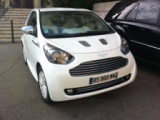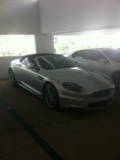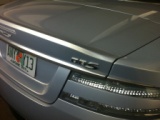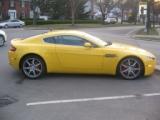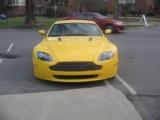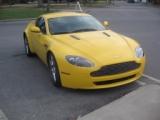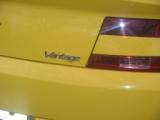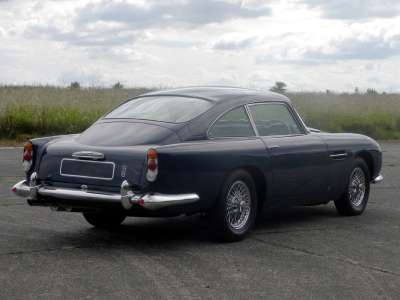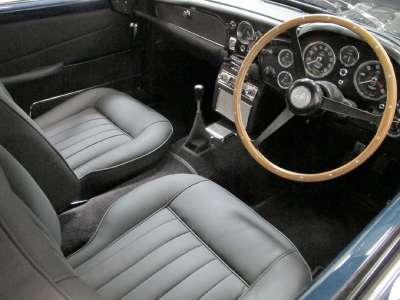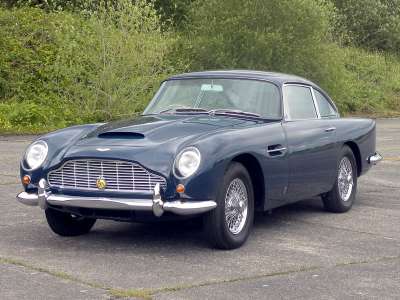Reg Number: CLX654B
Chassis Number: DB5/1653/R
Engine Number: 400/1641
Cc: 3995
Body Colour: Sierra Blue
Trim Colour: Grey
MOT ExpiryDate: T.B.A.
Think Bond, James Bond and, despite his countless other
modes of transport, you'll probably picture the silver DB5s
of Goldfinger and Thunderball. The question is, does he who
drives a DB5 automatically assume the charismatic ways of
Ian Fleming's all-conquering hero - the American who paid
almost £3 million for the begadgeted star of those
blockbuster movies presumably hoped so? However, exciting as
that dream may be, the fact is the standard DB5 is itself a
bewitching beast and has much to offer us ordinary mortals.
It is for good reason the model has become the major star of
all the David Brown Aston Martins, and examples with famous
names in the log book inevitably tend to have still greater
allure.
The DB5's DNA grew out of the DB4; a very different car
from the DB MKIII it replaced. Launched at the 1958 Paris
Motor Show, it featured a new platform chassis conceived by
Harold Beech. This was topped by a cage of small diameter
tubes clothed in hand-made alloy body panels. The process,
known as superleggera (lightweight), was evolved by
Carrozzeria Touring of Milan and employed under licence by
Aston Martin at its Newport Pagnell plant - the DB4 was the
first model to be built in full at the site.
The newcomer was powered by an all-aluminium DOHC
straight-six engine of 3670cc, conceived in house by the
company's Polish designer Tadek Marek. When topped by the
standard twin SU HD8 carburettors, it produced in the region
of 240bhp - sufficient to power the Aston to 60mph in nine
seconds and on to a top speed of some 140mph. Braking was by
servo-assisted discs all round. The front suspension was
independent by wishbones and coil springs, while the rear
featured a coil sprung live axle further located by a Watts
linkage. Steering was by rack and pinion. Over its six year
reign, the DB4 was progressively developed through five
'Series'.
The most visible changes concerned the addition of window
frames for the Series 2 and the adoption of a barred (as
opposed to egg crate) grille for the Series 4 cars. The
Series 5 cars introduced in September 1962 were both longer
(9 cm) and taller. However, the overall height was
maintained by changing from 16-inch to 15-inch diameter
wheels. Almost all Series 5 models were built to 'Vantage'
specification - ie they featured the 'special series' 266bhp
engine with its triple SU carburettors, bigger valves and
higher compression, plus the faired-in headlights from the
DB4GT, with the addition of a chrome surround. This final
iteration of the DB4 can be considered a prototype DB5 in
all but name.
So, more evolution than revolution, the DB5 was still a
significant step forward when it took to the stage in 1963.
For a start it was faster than its predecessor. Courtesy of
a new 3995cc 282bhp triple carburettor version of Marek's
masterpiece, it was now reputedly capable of almost 150mph
and could reach 60 mph in a whisker over seven seconds.
Initially there was the option of a five-speed ZF gearbox,
but this soon became the standard fit. The car's general
specification had also improved and now included: an
alternator in place of the dynamo, reclining seats, pile
carpets, electric windows, tinted glass and four silencers
for the exhaust. A total of some 898 DB5s are understood to
have been produced at Newport Pagnell before the model was
replaced by the altogether larger, Kamm-tailed DB6 in late
1965.
By 1964, post-war austerity had long since given way to a
culture of hope and hedonism. The sexual revolution was in
full swing and the 'Fab Four' were flying high on both sides
of the Atlantic. Fresh from its starring role in Goldfinger,
Aston Martin's DB5 was the perfect trophy for the exciting
new breed of celebrities. With their new found fame and
fortune, the Beatles could afford any car they wished and
eventually had many between them, from John Lennon's
psychedelic Rolls-Royce Phantom V to George Harrison's
Ferrari 365 GTC.
Prior to the group's 1964 World Tour, Paul McCartney
placed an order for what is believed to be his first Aston
Martin - a Sierra Blue DB5 with Black leather trim, and the
British Motor Industry Heritage Trust confirms that the car
we now offer, chassis 1653/R, was indeed first registered to
the man himself. According to the factory record, it was
built on July 3rd and seemingly despatched to the musician's
accountants, Bryce, Hanmer & Isherwood on September 22nd.
The factory-fitted extras included: Selectaride suspension,
Motorola radio, chrome wire wheels and, most interestingly,
a Phillips Auto-Mignon record player. The purchase price was
£3,800 10s 0d plus £793 6s 8d tax. One item not mentioned on
the accompanying BMIHT certificate but reportedly confirmed
by the Aston Martin trimmer responsible - who is still
working at Newport Pagnell - was the stitching of a special
musical note motif into the leatherwork. Although, no longer
with the car a part of the bespoke hide has survived (see
photo) and can be made available to a new owner for the
purposes of replication.
The Aston had its 500 mile service on October 7th 1964
and is known to have covered 40,513 miles by the time a new
clutch was fitted and other remedial work carried out in
1970. It seems likely that it was at this point the car
first changed hands, the next known owners being Truebell
Stationers of Wandsworth, London. More recent keepers
include John Richard Rogers of Ilford who acquired it on
March 12th 1983 and John Hardy Shannon to whom he sold it on
July 16th 1996. The vendor acquired this enticing item of
Beatle memorabilia in 2002. Four years later he entrusted it
to British car specialist Walter Baroni of Corsico, Milan
for an extensive 'back-to-bare-metal' cosmetic restoration,
the work on which was finally completed earlier this year.
Unlike Sir Paul's 1966 Aston Martin DB6, registration
'LL0 840D', period photos of the DB5 are elusive and written
quotes relatively few and far between. Moreover, it would
appear that some internet references confuse the two cars,
for example, a diary piece notes how Jane Asher (Paul's
girlfriend at the time): "helped him select his new car, a
midnight Blue Aston Martin DB6." This almost certainly
refers to the DB5, as the DB6 (though later resprayed Blue
before returning to its original colour and forming part of
Aston Martin's own collection) was in fact Goodwood Green
when new.
The September 22nd 1967 issue of Time magazine was more
precise and noted in the language of the day: "Batchelor
Paul, 25 (his favorite 'bird' is 21-year old actress Jane
Asher), is a movie addict, loves 'the look of London', and
tools around town in a spiffy Blue Aston Martin DB5."
Reminiscing about his band's 1965 UK tour, Roger McGuinn of
The Byrds recalled: "The Beatles had come to see one of our
gigs and we all hung out after the show. The next night I
went to Paul McCartney's club in St James and he took me out
for a drive around London in his Aston Martin DB5. It was a
really amazing time." On his own company website, life-long
fabricator Keith McEvoy recalls with pride how he was
involved in building the chassis for both the Bond DB5 and
McCartney's car during his days as an Aston Martin
craftsman.
The phrase 'national treasure' has become somewhat
over-used in recent years, but seems appropriate enough when
referring to the immortal DB5 and never more applicable than
in relation to Sir Paul McCartney. The chance to purchase
the ex-McCartney DB5 is therefore surely something to savour
for Aston Martin and Beatle fans alike. For reference, the
ex-George Harrison DB5 changed hands at RM Auctions London
sale of 2007 for $464,736.
Courtesie Classic C
SUPPIED NEW
TO GEORGE HARRISON
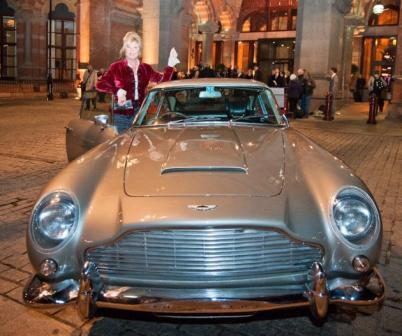
An Aston Martin DB5 that was ordered by Beatles guitarist George
Harrison is up for auction in London on Tuesday.
Coys has consigned chassis DB5/1896/R, the 1964
DB5 that was supplied new by Brydor Cars of
Brooklands to Harrison, for its 7 December sale
at the Royal Horticultural Halls in Westminster.
Coys' Chris Routledge said: "We are offering
a once-in-a-lifetime opportunity to acquire not
only one of the most collectible examples of the
marque, but one that has been owned by arguably
one of the world’s most influential musicians."
"It was delivered to him personally in 1965
at his Kinfauns estate in Esher," added
Routledge, who recently reunited the Newport
Pagnell car (above) with Pattie Boyd – the
Beatle star’s wife when he owned the Aston. It’s
expected to sell for £225-260,000.
Courtesie Classic & Sports Cars





